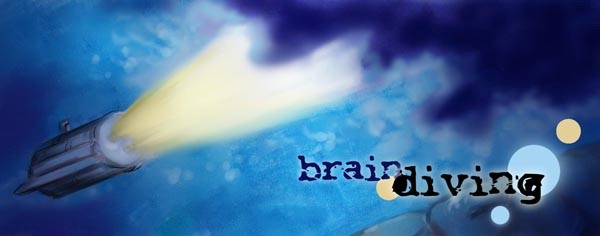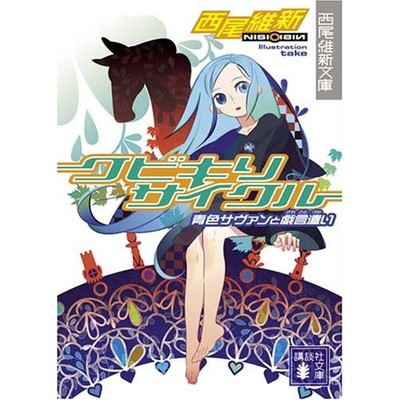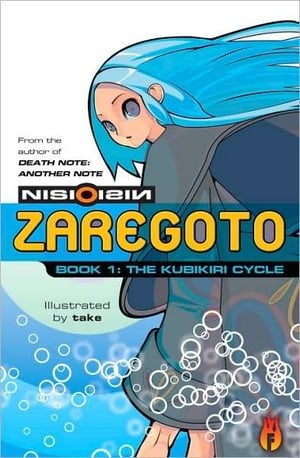Brain Diving
The Men Who Stare at Zaregoto
by Brian Ruh,


I have to admit that I was rather surprised earlier this year when I saw that Del Rey was publishing the second volume in NISIOISIN's Zaregoto series. Frankly, the first volume was best known to me for its omnipresence at my local Half Price Books store. With its cover price of a whopping single dollar and a mark across the bottom of its pages, the many copies of Zaregoto Book 1: The Kubikiri Cycle I'd seen around had obviously been remaindered. Of course, this means nothing about a book's intrinsic work or its entertainment value, but I figured that someone had to have seen something worthwhile to try to re-kindle a series that had been dormant for two years. (When the books were first published in Japan, there was a mere three months between the first and second volumes.)
Since his debut in 2002 with the first Zaregoto book, the author known as NISIOISIN has quickly made a name for himself in anime and manga circles. He has written tie-in novels for both the xxxHolic and Death Note franchises, both of which have been published in English (although, since I don't particularly follow those series, I haven't read either). Some of his later novel series, Bakemonogatari (2006) and Katanagatari (2007) have been adapted into anime series, and his Kizumonogatari (2008) novel has been confirmed for an upcoming anime adaptation. For some of the series he has written, NISIOISIN has turned out as much as one new book every month, making him a very prolific author. In addition to his novels, he has also worked in manga, including collaborations with Yun Kouga (artist for Loveless) and Takeshi Obata (artist for Death Note), as well as writing the story for the ongoing Medaka Box manga.
One of the things that struck me when reading the first Zaregoto book was how much it seemed like a classic detective novel. Take away the anime-esque illustrations by take, remove some of the nods toward otaku culture such as maids and references to the Tezkua manga Blackjack, and you're left with a solid locked-room mystery. I find this intersection of otaku culture and detective fiction to be really interesting because of the role the detective story has played in the development of anime and manga.
Even though anime and manga can come in all flavors and genres, its foundational roots are in science fiction. Through Astro Boy, Doraemon, Space Battleship Yamato, Gundam, Macross, and the like, anime and manga found its footing and its popularity, particularly within fan culture. In turn, many scholars of science fiction trace the genre's origins in Japan to the 1930s and what was known as “irregular detective fiction.”According to one scholar, it was named this because it “differed from the more objective and rational methods of regular detective fiction.” This connection between detective fiction and science fiction makes sense – a detective story requires practical application of scientific principles in order to solve a crime, and it was by taking the ideas present in the detective story and twisting them or pushing them to new extremes that the genre of science fiction began to develop in Japan in the early twentieth century.
Before I discuss the first two Zaregoto novels, I thought it would be interesting to consider a brief history of Japanese science fiction in this week's Read This! section. The article is called “Generations and Controversies: An Overview of Japanese Science Fiction, 1957-1997” by Takayuki Tatsumi (author of the fantastic book Full Metal Apache) and it gives a thorough yet concise rundown of the postwar history of Japanese SF. Although, as I mentioned above, SF in Japan has its roots in irregular detective fiction, it didn't really begin developing as a popular medium until the late 1950s, when the first magazines devoted to science fiction began to be published. The genre began to grow throughout the 1960s with the establishment of the first conventions, awards, and professional writing groups. Tatsumi divides the postwar SF writers into four distinct time periods roughly by decade – the “founding fathers” of the first generation of the 1960s, the New Wave second generation of the 1970s, the “Post-New Wave/pre-cyberpunk” third generation writers of the 1980s, and the postmodern / cyberpunk fourth generation writers of the late 1980s and early ‘90s.
Of particular interest to anime and manga fans may be a term that Tatsumi uses to describe a characteristic of this fourth generation – “yaoi poetics.” Since he's writing in this article for an audience more acquainted with Western SF, Tatsumi calls it “the Japanese equivalent of the K/S [Kirk-slash-Spock] slash fiction aesthetic.” In other words, one of the characteristics of this fourth generation of Japanese SF is that it delights in reinterpreting and reusing previously existing characters and situations. Just as in yaoi, where stories are reinterpreted to pair male characters in homosexual relationships for the pleasures of their (often) female fans, SF stories with such “yaoi poetics” do not hesitate to play around with characters and structure to give readers the thrill of recognizing familiar elements within a new story. Although he's not necessarily a science fiction author, from this perspective NISIOISIN would certainly be engaging in these types of “yaoi poetics” through his stories.
 Zaregoto Book 1: The Kubikiri Cycle and Zaregoto Book 2: The Kubishime Romanticist by NISIOISIN
Zaregoto Book 1: The Kubikiri Cycle and Zaregoto Book 2: The Kubishime Romanticist by NISIOISIN
Although my initial impression of the first Zaregoto book was a bargain bookstore throwaway, I was intrigued enough that Del Rey was releasing the second book that I went back to revisit these two novels. I am certainly happy that I did so. I haven't read up any of NISIOISIN's works in Japanese, but I have to say that if he keeps up this quality across his body of work then I am very impressed. NISIOISIN is obviously aiming at creating an intelligent, media-savvy pop literature, and based on what I've read from what is admittedly a small sliver of his entire output, he seems to be succeeding. In a single volume, NISIOISIN references both Japanese literature like Dazai and Akutagawa as well as AT fields and period dramas.
In the first Zaregoto book, NISIOISIN introduces us to the narrator Ii, a young man in his late teens who is accompanying his friend Tomo Kunagisa to a peculiar island just off Japan's coast owned by the powerful Akagami Foundation. The lady of the island was Iria Akagami, who would amuse herself by regularly inviting geniuses of various types to stay on the island for as long as they wished. Kunagisa, a blue-haired engineering and computer whiz, had accepted Akagami's offer and decided to come to the island for a few days with Ii in tow. There were four other geniuses on the island at the time, whose specialties included fortune telling, cooking, and painting. With the painter's attendant, Akagami, and the four house maids, there were a total of twelve people on the island. However, when one of the twelve is found decapitated in a seemingly locked room, the search for the killer begins.
Although I like detective stories and whodunits well enough, I wouldn't call myself a fan. That said, I quite enjoy the general concept of the locked room mystery, which must be difficult for mystery authors to set up in new and convincing ways. No matter how well-crafted the characters are, such mysteries really hinge on the setup and solution to the main mystery – it needs to initially seen impossibly airtight, but then be able to be convincingly solved with the clues made available to both the characters and the reader. In this regard, The Kubikiri Cycle certainly fits. I find that the mark of a good mystery book is how much brainpower you devote to solving the mystery when you're not reading the book, and I have to say that this is one that I just kept thinking about.
The second Zaregoto book is a little different in execution, although it is still essentially a murder mystery. After returning from the island, Ii goes back to school at Rokumeikan University in Kyoto (a thinly fictionalized Ritsumeikan University, which NISIOISIN attended for a time). He is invited to a small birthday party with some new classmates, but the guest of honor turns up dead the following morning, so Ii begins trying to figure out what happened. At the same time, he knowingly befriends a young man who is a serial killer and has been terrorizing Kyoto with his seemingly random murders.
Although Ii tries to solve a murder that grows into a string of killings, The Kubishime Romanticist places less of an emphasis on trying to solve the mystery than on studying the motivations behind the characters’ actions. I hope this isn't considered a spoiler, but by the middle of the book Ii has pretty much figured everything out. However, even though Ii is the narrator not only does he not let the audience know that he has solved the mystery, he intentionally withholds information from us so that we might be able to figure out what is going on. When I first read the book I thought this was a cheap trick to have such an unreliable narrator. However, when I thought about it some more, I realized that this is in keeping with Ii's personality and in a way makes perfect sense.
Ii tells the stories in the books through his own perspective with a first-person narrative, but he really is more of an antihero than a hero. In a key character train that could be considered an homage, Ii is apathetic much like Shinji in Neon Genesis Evangelion. He doesn't hate much of anything, but he also doesn't like much of anything either. He is like a discarded soda bottle floating, bobbing along with this tide, going wherever the ocean currents take him. This is how he ended up getting dragged to the island by Kunagisa in the first book and why he attended the birthday party in the second. Ii has a very philosophical outlook to life, and his reaction to the world is in part a defense mechanism. As he says in The Kubishime Romanticist, “If it meant never being sad, I didn't have to be happy. If it meant never failing, I didn't have to succeed.” He is passive and will easily lie if there is no reason to tell the truth. This isn't really on display so much in the first book when Ii is around his close friend Kunagisa who, in spite of everything, loves Ii. Many of the other characters on the island are harsh toward Ii for reasons that aren't always apparent to the reader. However, more of Ii's character comes out in the second book, in which his relationship with the Kyoto serial killer is key. When Ii and the killer first encounter one another, there is an immediate sense of recognition as if they are similar at heart. Once he knows who the killer is, though, Ii doesn't contact the police even though it could save lives, and when he hears the killer has claimed even more victims he doesn't feel a hint of remorse. Such an amoral (one might even say anti-moral) character is unusual as a series hero for an anime, manga, or light novel, which helps to set the Zaregoto books apart.
Even though I found them to be a fun read, one of the things I'd pick on with these books is that the names almost always have honorifics at the end of them. This is one of my big translation pet peeves – I think a translation should read as smoothly as possible in its new language, which means that no knowledge of the original language should be required. However, there are -sans and -chans throughout the Zaregoto books to the extent that I found it to be distracting. It can also give the wrong impression to the reader who may not know how such titles work in Japanese. For example, on the back of both books the narrator is referred to as “Ii-chan” as if it is his name, yet in the second book he meets a young woman who calls him “Ikkun,” which makes little sense unless you know his name is Ii and “-chan” and “-kun” are honorifics denoting familiarity and status. Some would argue that translations should have these honorifics in there to show the reader the relationships between the characters. However, I think that if the translator is doing a good job of translating the story as a whole, then such things aren't needed. (In general, though, Greg Moore did a good job translating both books; the honorifics just seem superfluous and distract from the overall flow of the story.)
I would certainly love to read more from NISIOISIN, and given his level of output, there's certainly no shortage of titles to choose from. Even within the Zaregoto series there are still seven more books, and there are enough hints about Ii's formative years in the first two books to make the reader want to figure out what happened to make him the amoral creature that he is. Since the Zaregoto series was published in English by Del Rey manga, I would expect that if any future volumes come out they would now be handed by Kodansha USA, which has recently taken over publication of the titles that Kodansha owns in the US. Much of the talk regarding the new Kodansha USA situation has centered around manga titles, so I have no idea what plans, if any, exist for their prose titles. I'm not going to hold my breath, but I know I'd love to see more light novels along the lines of Zaregoto. (And another volume of the Faust anthology would be great as well. It seems like a good portion of the Japanese novel series I'm interested in seem to get stuck after the second volume.) Of course, as will all things like this, we vote with our wallets; I've already placed my vote for NISIOISIN.
Brian Ruh is the author of Stray Dog of Anime: The Films of Mamoru Oshii. You can find him on Twitter at @animeresearch.
discuss this in the forum (10 posts) |
this article has been modified since it was originally posted; see change history